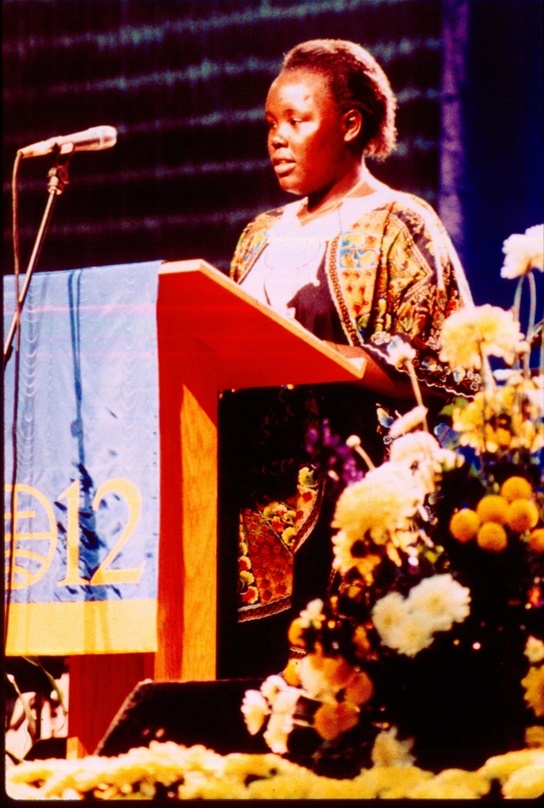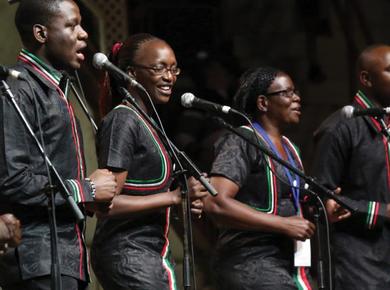Posted: May 16, 2017
Mennonite Churches in Eastern Africa
“In the traditional African religious experience, the expression of faith was never understood in universal terms,” writes Alemu Checole, assisted by Samuel Asefa, in Anabaptist Songs in African Hearts, in the Global Mennonite History series. “Beliefs and practices varied from one locality to another, from one tribe to another. Religious expression was always understood to be a Luo, Maasai, Turkana, or Zanaki expression of faith.
“African Christians accepted Christianity, however, because they saw in it a new way of life, one which was profoundly better than their traditional existence. For example, their hope for eternal life, assurance of the forgiveness of sins, peace and reconciliation with God and humanity assured them of security. The new Covenant sealed by the blood of Christ united them in a new universal community of faith.”
Elam and Elizabeth Stauffer and John and Ruth Moseman were among the first Mennonite missionaries to enter Tanzania (then called Tanganyika) to plant churches in the region in the 1930s. Zedekiah Kisare, a young African Christian, was their interpreter at their Sunday services.
Mission stations were established in Bukiroba, Mugango, Bumangi and Nyabasi among local tribes in the area.
In addition to sharing the gospel and starting churches, a school was established at each mission station, several hospitals and local clinics were established and the missionaries started a girls home.
In 1942, a revival began. Sparked by an African evangelist, revival swept through the region. “On the whole, this wave of revival in east Africa touched people from every walk of life,” write Checole and Asefa. “It brought unity between missionaries and Africans and created sympathy and understanding between the two races.”
As countries of east Africa moved toward independence from colonial rule, however; there was a transition for the missionaries as Africans moved into leadership within an African framework.
In 1948, the Mennonite missionaries in Tanzania discussed building an indigenous African Mennonite Church with an organizational structure built on three ministry offices: bishop, pastor, deacon.
In 1950, men who had served as lay preachers for more than 15 years were ordained; given authority to baptize, administer the Lord’s Supper and perform weddings. Ezekiel Muganda, Andrea Mabeba, Zedekiah Kisare and Nashon Kawira Nyambok were ordained as pastors.
“The sense of oneness in the Spirit, the joy and appreciation at finding national pastors, aroused great interest in the work of evangelism,” write Checole and Asefa. Despite many hardships evangelists faced as they moved from place to place, their ministries produced the fruit of converts.
When Tanzania gained independence in 1961, church leaders had to wrestle with questions of nationalism. Churches saw the importance of inculcating the value of responsibilities of leadership in their youth. The Tanganyikan Mennonite Church Youth League was organized in with Daniel Matoka assisting Shemaya Magati with leadership. Youth activities included cleaning the church, receiving offerings, helping with Sunday school programs, singing and gardening.
In 1964, the Tanzanian Mennonite Church chose it first national bishop, Zedekiah Kisare of the Luo tribe. Tensions from Bantu tribes stirred, but their candidate Ezekiel Muganda made peace instead of challenging leadership, and Kisare was ordained in 1967 just as socialism was proclaimed in the country.
The political boundary between Kenya and Tanzania divides tribal areas. In 1942, Ogwada Okach and Nikanor Dhaje felt compelled to cross in to Kenya to proclaim the gospel. They were the first Mennonite evangelists from Tanzania to travel into Kenya to witness and nurture Christian groups emerging at Bande, Nyangwaye and other places. From the beginning, the Kenyan Mennonite Church has been “a grassroots movement of the rural poor,” writes Philip E. Okeyo in Forward in Faith.
Kenya became an independent state in 1963. In 1965, the government of Kenya recognized the fourth petition to recognize the Mennonites as a church body. However, the Kenya Mennonite Church remained part of the Tanzanian church until 1977 when Bishop Kisare worked with pastors to set their own structure for Kenya.
In 1980, Eastleigh Fellowship Centre was opened in Nairobi. This community centre with a library, classrooms and sports spaces provides “a Christian witness and presence, offering an opportunity for conversation and sharing between various religious communities, providing constructive recreation and help for low-income families and students, thus improving the quality of their lives,” write Checole and Asefa. Though the Kenyan Mennonite churches have seen conflict within themselves, this centre has given them a reputation for peace and relations with Muslims.
Over in Tanzania, Mennonite convictions of non-resistance were tested by the 1978 war with Uganda. Some church members joined the military to fight, but others like Christopher Ndege stood firm on religious convictions of non-resistance despite a court challenge.
Around this time, the church, which had expanded, elected pastor Hezekiah N. Saria, to serve as bishop over the second diocese. Under his leadership, tensions arose between regions and tribes. There was “a kind of stagnation in church growth” and a “spiritual malnutrition,” Checole and Asefa write. Now, new leadership “is trying to bring peace and reconciliation to the KMT.
As for Kenya, despite growing pains, “a church which began in a village in a single ethnic community has now crossed over to other tribes, such as the Kikuyu, Luhya, Mijikenda, Nandi, Maasai, Somali, and others, even in Uganda” writes Okeyo in Forward in Faith.
“The gospel transcends all cultures and should challenge every cultural heritage. Because of the marvelous work of Jesus Christ, millions of Christians in Africa live in joyous hope and faith. Through Jesus the powers of death are defeated; victory is made certain because Jesus is Lord. The gospel is the Good News for the whole person.” write Checole and Asefa.
—Karla Braun is editor of Courier and writer for Mennonite World Conference. She lives in Winnipeg, Canada.
This article first appeared in Courier/Correo/Courrier October 2016
Did you know?
Kenya has more than 40 million people.
Kenya’s population reports as80% Christian, 7% Muslim, 13% African religions and other smaller groups like Hindus.
Tanzania has more than 50 million people.
Some 70% of Tanzania’s inhabitants are rural.
Learn more about Mennonite churches in Africa:
Anabaptist Songs in African Hearts, 3rd ed. Global Mennonite History Series 1. Lapp, John A. and C. Arnold Snyder, gen. eds. Kitchener, ON: Pandora Press, 2006.
Forward in Faith: History of the Kenya Mennonite Church, A Seventy-Year Journey, 1942–2012. Ojwang, Francis S. ed. Nairobi: Kenya Mennonite Church, 2015.
Mennonite national churches in Kenya |
|
Brethren in Christ Church
Kenya Conference
Members 4,900
Congregations 25
Headquarters Nakuru
Presiding officer Samuel Muriithi (bishop)
|
|
Christian Believers Fellowship
(Beachy Amish Church)
Members 693
Congregations 16
Headquarters Kisumu
Presiding officer Marlin Stoltzfus (senior bishop)
|
|
Christian Church International
Members 19,640
Congregations 320
Headquarters Madaraka, Thika,Central
Presiding officer Joseph Mburu Kamiri (bishop)
|
|
Church of God in Christ, Mennonite
Members 139
Congregations 9
|
|
Kenya Mennonite Church
Members 11,800
Congregations 142
Headquarters Nango
Presiding officer Philip E. Okeyo (bishop moderator)
|
Mennonite national churches in Tanzania |
|
*Kanisa la Mennonite Tanzania
Members 65,456
Congregations 400
Headquarters Musoma
Presiding officer Steven Watson Mang’ana (bishop)
|
|
* indicates membership with MWC
|
| Source: MWC World Directory 2015 |

Join the Conversation on Social Media
FacebookTwitterInstagramFlickrYouTube